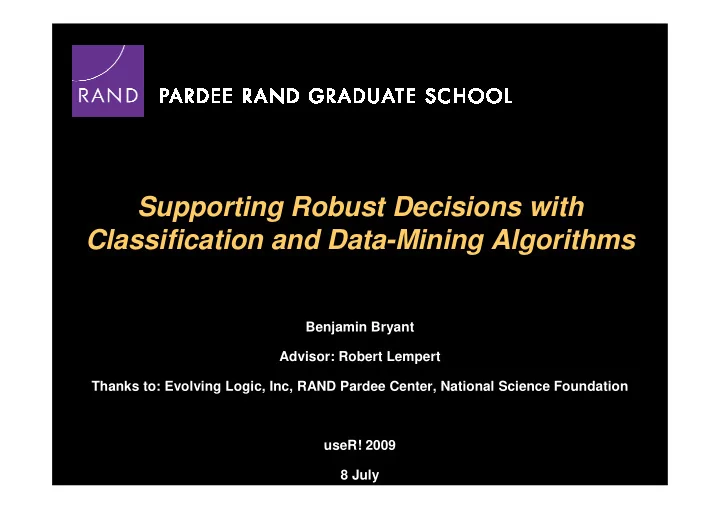

Supporting Robust Decisions with Classification and Data-Mining Algorithms Benjamin Bryant Advisor: Robert Lempert Thanks to: Evolving Logic, Inc, RAND Pardee Center, National Science Foundation useR! 2009 8 July
Outline • Policy analysis, robust decisions and the “scenario discovery” concept • The PRIM algorithm as a means to implement scenario discovery • Demo of the ‘sdtoolkit’ PRIM implementation • Future directions 2 8 July 2009
We are interested in methods to support long-term, deeply uncertain decisions • For example: – Climate change adaptation – Terrorism risk • Variety of techniques could be applied – Qualitative scenarios (no formalized mathematical model) – Probabilistic analysis (optimization and/or risk hedging) • The “Robust Decision Making” (RDM) approach combines quantitative modeling with intuitive appeal of scenarios – Goal: Find policy options that are robust against all combinations uncertainties 3 8 July 2009
Scenario Discovery is one step in the RDM process Assess alternatives Candidate Identify for ameliorating strategy vulnerabilities vulnerabilities • Views “scenarios” as vulnerabilities of policies: States of the world where policy performs poorly • Uses a simulation model to examine policy performance over many combinations of uncertainties • Uses classification and/or data-mining algorithms to find regions of uncertainty space where the policy performs poorly – These regions represent possible future states of the world and become quantitatively defined “scenarios” 4 8 July 2009
Current scenario discovery algorithms identify scenarios as ‘boxes’ Box = restrictions of parameters describing region of input space Algorithm magic 5 8 July 2009 (filled points = interesting) *Dataset entirely contrived for illustration
Boxes translate to concise sets of parameter restrictions • In previous case: Box 1: growth > .5 efficiency < .4 Box 2: .25 < growth < .4 .6 < efficiency < .9 6 8 July 2009
Three measures characterize ‘goodness’ of box set Density: Interesting cases (points) captured / Total captured Coverage: Interesting points captured / Total interesting Interpretability: Some decreasing function of the number of boxes & dimensions restricted These measures are generally in tension and no all-purpose objective function exists, so: Seek algorithms to populate an efficiency frontier relating measures. 7 8 July 2009
We use the Patient Rule Induction Method to generate many candidate boxes • PRIM is a “bump-hunter,” tries to find regions of input space with high output value • Interactive by design – Produces many boxes, provides information to help the user choose among them • Original version of PRIM not designed for scenario discovery specifically, but we made a few modifications 8 8 July 2009
Prim works by peeling and pasting… 9 8 July 2009 Source: Elements of Statistical Learning, by Hastie, Tibshirani, Friedman
R package ‘sdtoolkit’ adapts PRIM for scenario discovery • Long-term idea is to serve as environment for integrating functionality of multiple algorithms, post-processing, and visualization • Currently implemented only with PRIM, but hopefully incorporate additional algorithms • At present, toolkit provides the following features: – Coverage-oriented statistics and tradeoff curve (in addition to support) – Contour plots which indicate dimensionality on the peeling trajectory – Automatic generation of ‘normalized restriction plots’ – Automatic generation of color coded scatter plots with boxes drawn – Reproducibility and (quasi)-statistical significance tests 10 8 July 2009
Demo of sdtoolkit 11 8 July 2009
There are many potential additions to the scenario discovery interface • Adding additional box-finding algorithms to toolkit – eg, CART • Generate and sort approaches • Improved search through box space • Enhanced visualization of tradeoffs and boxes (3D!) 12 8 July 2009
Even more theoretical work could inform and broaden scenario discovery implementations – Sampling design – Relationship of sampling to scenario significance – Dataset and box diagnostics informed by other data-mining algorithms – esp clustering – Non-box shapes that are still interpretable – Interactive sampling/scenario-search for models with prohibitive run time 13 8 July 2009
Thanks! • Scenario discovery references: • Bryant, B.P. (2009) “sdtoolkit: Scenario Discovery tools to suport Robust Decision Making.” Contributed R package: http://cran.r-project.org/web/packages/sdtoolkit/index.html Bryant, B.P. and R.J. Lempert (2009). Thinking Inside the Box: A participatory, computer- assisted approach to scenario discovery. In revision. Groves, D.G. and R.J. Lempert (2007) A new analytic method for finding policy-relevant scenarios. Global Environmental Change , Vol. 17, No 1, 2007, pp 78-85. Available at: http://www.rand.org/pubs/reprints/RP1244/ Lempert, R.J, B.P. Bryant and S.C. Bankes. (2008) Comparing algorithms for scenario discovery. WR-557-NSF, RAND Working Paper Series, Santa Monica: Calif. Available at: http://www.rand.org/pubs/working_papers/WR557/ Lempert, Groves, Popper, and Bankes, 2006, A General, Analytic Method for Generating Robust Strategies and Narrative Scenarios, Management Science , 52(4). Available at: http://www.rand.org/pubs/library_reprints/LRP20060412/ • PRIM reference: Friedman, JH. and Fisher, N. (1999) Bump hunting in high dimensional data. Statistics and Computing. 9, 123-143. Contact: bryant@prgs.edu 14 8 July 2009
Practical problems inhibit effective scenario assessment • Existing algorithm interfaces lack: – Coverage oriented statistics and visualization – Means to assess significance of dimension restrictions – Sufficient interactivity 15 8 July 2009
CART works by partitioning 16 8 July 2009
Recommend
More recommend